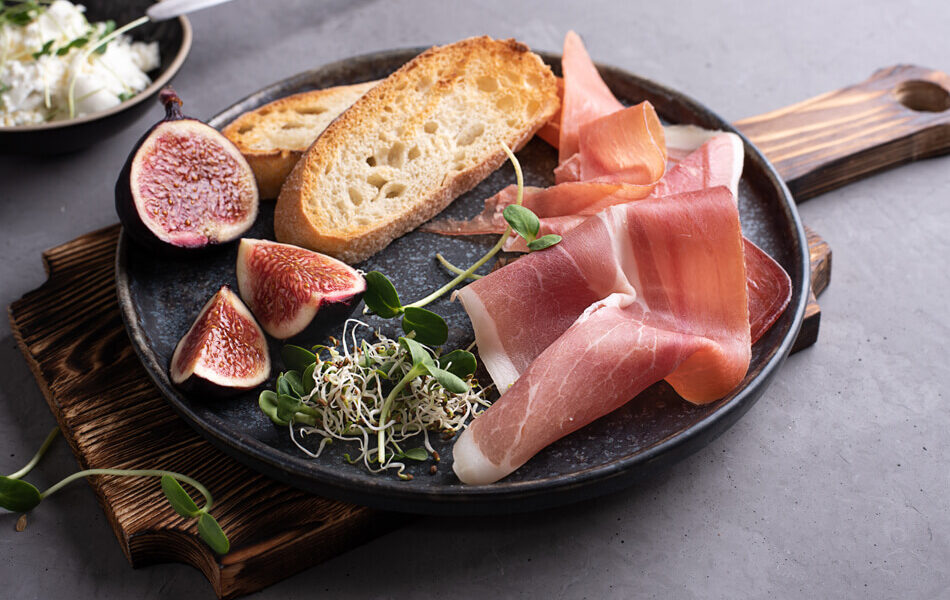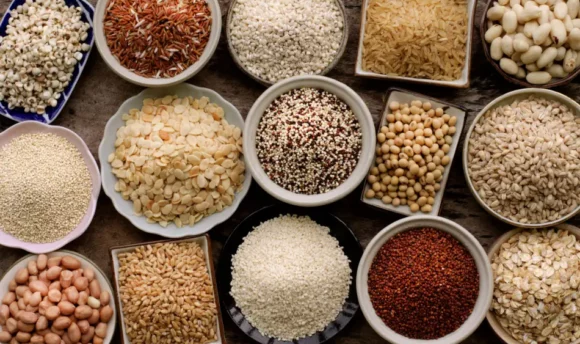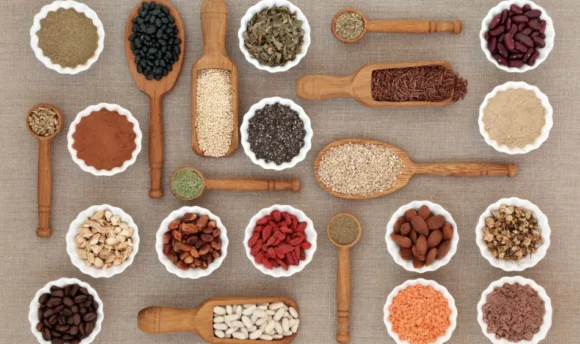Is Prosciutto Healthy? Nutrition and Calories
Processed meats have a bad reputation, but these foods have some health benefits if consumed in moderation. This article reviews the nutrition facts of prosciutto to identify if this popular deli meat is healthy to consume.

Prosciutto is deliciously sweet and salty with a ton of flavor. It is a versatile product you can enjoy in salads, sandwiches, and as a primary component on cheese and charcuterie boards alongside other cured meats. You can even wrap slices of prosciutto around fruit and veggies.
As prosciutto is considered processed meat, it raises questions about how healthy it is to consume. Processed meat is known for being high in sodium and saturated fat. If you’re practicing healthy eating, reviewing the nutritional composition of the foods you eat is critical.
In this article, we look at the health benefits of eating prosciutto. Discover everything you need to know, including nutrients, calories, sodium, and fat content.
Is Prosciutto Healthy?
Prosciutto is not a particularly healthy food. However, it can be a healthy addition to your diet when eaten in moderation. It has a relatively high-fat content and a fair amount of calories. With limited consumption, you can enjoy some health benefits when you eat prosciutto. It has protein, vitamins, and minerals like iron and thiamine to support health.
When it comes to eating prosciutto and other processed meats, the simple solution is to watch your intake and enjoy these foods in limited quantities. That way, you can get the nutrients they contain without harming your health.
Prosciutto (ham in Italian), also known as prosciutto di parma, prosciutto crudo, or Italian prosciutto, is a dry cured ham made from pork leg. It is an uncooked, processed red meat made using a curing process. It is cured with salt, giving prosciutto its tasty salty flavor.
Red meat and especially processed meat are known for being unhealthy foods. They tend to contain lots of saturated fat and too much salt. Eating them regularly may increase your risk of cardiovascular disease, diabetes, and certain forms of cancer, including stomach and colorectal cancer.
Processed red meat isn’t all bad. It is full of protein and other vitamins and minerals that can support a balanced diet.
A 100g serving of prosciutto has 21.4g of fat, 12.5g of which is saturated fat. While unsaturated fat promotes heart health, saturated fat can increase coronary heart disease risk. It’s best to replace these with healthy fats to keep your heart health in check.
Prosciutto Nutritional Facts
Now, we’ve briefly covered the nutrients that prosciutto contains and why it’s important to be mindful of your prosciutto intake. To better understand what you’re putting into your body when you eat prosciutto, check out the table below.
Nutritional table (per 100g)
| Calories/Nutrient (per 100g) | Amount |
| Calories (kcal) | 286 |
| Sodium (mg) | 2,290 |
| Net Carbs (g) | 0 |
| Fiber (g) | 0 |
| Sugar (g) | 0 |
| Fats (Total) | 21.4 |
| Protein (g) | 25 |
| Cholesterol (mg) | 89 |
High in vitamins and minerals
Although processed red meat and perceivably an unhealthy food, prosciutto does contain some essential vitamins that are good for your overall health. Prosciutto doesn’t have some essential macronutrients, like carbohydrates and dietary fiber, but it does have other nutrients.
Prosciutto is a moderate source of iron – an essential mineral your body needs for muscle development and carrying oxygen in the blood from the lungs to every other cell.
Prosciutto provides B vitamins, including thiamine (B1), riboflavin (B2), niacin (B3), folate (B9), and vitamin B12. B vitamins support enzyme function and various cellular functions, playing an important role in general health and wellness. A regular intake of dietary thiamine is necessary for maintaining healthy blood levels.
The primary concern with prosciutto is its high salt content. A 100g serving of prosciutto has 2,290mg of sodium. The American Heart Association recommends consuming no more than 2,300mg of sodium per day for most adults.
While 100g is a relatively large serving size of prosciutto it still should be consumed in moderation because it is easy to reach the daily recommended sodium dose.
Sodium is necessary for maintaining fluid balance and nerve and muscle function. Too much can cause high blood pressure and weight gain, increasing heart disease and stroke risk.
You can further improve your nutrient intake from prosciutto di parma by pairing it with other nutrient-dense foods. Vegetables such as broccoli, asparagus, and carrots are excellent sources of nutrition. The salting process makes prosciutto deliciously salty. It can add flavor to just about anything.
High in protein
Adding one or two slices to nutritious meals is a great way to get enough protein in your diet. In moderation, it provides an adequate amount and a healthful boost to foods lacking in protein. To add flavor, you can add it to salads, pasta dishes, and your favorite vegetables.
A 28g serving of prosciutto has 7g of protein – a significant amount. A few slices of prosciutto will give you a generous dose of your protein intake. As it is thinly sliced, it’s easier to limit consumption.
Protein is an essential macronutrient that helps your body repair and make new cells. It is critical for your bones, muscles, and immune system. For those who want to gain strength, lose fat, and maintain muscle in the gym, protein intake is critical.
However, that doesn’t mean you should overconsume protein-rich foods. An adequate amount is unlikely to impact your weight, but too much can make you gain weight.
High in calories
Prosciutto, like other cured meats, is not considered a diet food because it is high in calories. There are just over 80 calories in a 28g serving. As you can imagine, eating several slices of prosciutto will quickly rack up your calorie count for the day.
The healthiest way to control your daily caloric intake is by balancing the calories in your meals. Eating high-calorie foods like prosciutto, parma ham, and chorizo can put you at greater risk of weight gain and obesity.
If you want to lose weight, you can benefit from following a low-calorie diet and eating nutritious, zero-calorie foods. For those who wish to enjoy prosciutto despite its calorie content, you can increase physical activity to ensure you burn more calories than you take in.
Low in carbohydrates
Most types of prosciutto do not contain carbohydrates or sugars. The prosciutto varieties that do tend to have a very minimal amount. It’s important to check the nutrition label if purchasing packaged prosciutto as it may differ from authentic, fresh prosciutto in terms of ingredients.
There are zero carbs in the 100g serving listed above, making prosciutto a perfect food for the keto diet. The keto diet is a low-carb, high-fat diet that pushes your body into an alternative metabolic state called ketosis. Getting into ketosis encourages your body to burn fat effectively, resulting in significant weight loss.
A moderate amount of fat
Prosciutto has a moderate amount of fat, with 21.4g total fat and 12.5g saturated fat. Dietary fat is an essential macronutrient, providing your body with energy and supporting cellular function. It provides fatty acids that the body cannot produce on its own.
The main fatty acid in prosciutto is oleic acid – an omega-9 fatty acid. Oleic acid is a beneficial fat that may help lower cholesterol, reduce inflammation, and promote heart health. Many of olive oil’s benefits are attributed to high levels of oleic acid.
Low in cholesterol
Prosciutto contains 89mg of cholesterol in a 100g serving. According to dietary guidelines, you should aim to consume no more than 300mg of dietary cholesterol per day. If you are at a heightened risk of heart disease, the recommendation reduces to 200mg daily.
It is important to keep your cholesterol levels within a healthy range. High cholesterol levels can trigger heart attacks and stroke as it clogs the arteries, reducing blood flow. You can lower your cholesterol by practicing healthy eating and getting regular cardiovascular exercise.
Healthy Prosciutto Recipe
Prosciutto works well with countless delicious recipes. To include prosciutto in your diet, it is always more beneficial to add it to healthy ingredients rather than eating it alongside fatty and high-cholesterol foods, such as cheese and other full-fat dairy products.
Below is one example of a simple, healthy recipe involving prosciutto – prosciutto-wrapped asparagus. It makes the perfect appetizer when you’re craving prosciutto’s salty taste.
Ingredients:
- 20 thick spears of fresh asparagus
- Olive oil or avocado oil
- Prosciutto (10 thin slices)
- Freshly ground black pepper
- Red pepper flakes
- Grated parmesan
Directions:
Step 1
Preheat the oven to 425ºF. Prepare the asparagus by chopping off the tough ends before applying a little bit of olive oil.
Step 2
Cut each slice of prosciutto in half, taking care to slice them evenly.
Step 3
Tightly wrap each prosciutto slice around the center of each spear of asparagus.
Step 4
Place the prosciutto-wrapped asparagus spears in a single layer onto a baking sheet. Lightly drizzle a little more oil before baking in the oven until tender and crisp for approximately 8–10 minutes. Enjoy!
FAQs
In moderation, prosciutto can provide some benefits to a balanced diet. As meat, it contains lots of protein, iron, and B vitamins, key nutrients for your body. However, too much prosciutto is bad for you because processed meat has high levels of salt, fat, and calories.
Authentic prosciutto, as in the Italian version, is free from nitrates. Prosciutto is cured with sodium only. However, there is often a huge difference between high-quality prosciutto products and cheaper varieties on the market which may contain nitrates.
Yes, prosciutto is safe to eat in moderation. Although eaten raw, the salt during the aging process prevents bacteria from entering the meat. You must, however, limit your intake of prosciutto because it is a processed food with a lot of salt and fat.
A Word From a Nutritionist
Prosciutto is a type of cured ham made from the pig’s hind leg. It is cured using sea salt, eaten raw, and typically served in thin slices. The salt acts as a preservative while enhancing the taste to give prosciutto its well-known flavor.
Prosciutto crudo fits into the Mediterranean diet, alongside olive oil and balsamic vinegar. It’s worth noting, however, that the Mediterranean diet recommends eating cured cuts only once or twice per week. It is primarily a plant-based diet and one of the healthiest in the world.
Prosciutto is a keto-friendly food. You can eat it on a ketogenic diet as part of your fat intake. The high amount of protein and fat provides a source of fuel for your body to burn instead of glucose from carbs. Other keto-friendly foods include avocado, eggs, and olive oil.
Prosciutto is processed red meat like sausage, bacon, ham, and hot dogs. Red meat is very nutritious, with iron, zinc, and B vitamins. Unfortunately, too much comes with health risks, making prosciutto best served in limited quantities.
The high saturated fat and sodium content can raise cholesterol levels, cause high blood pressure, and make you more prone to heart disease and stroke. If you are a meat-lover, you can benefit from eating leaner meats and poultry rather than highly-processed cured meats.
Conclusion
On the whole, prosciutto is not particularly good for your health. It’s best to reduce your salt intake where possible and cut down on prosciutto and other processed meats to lower the risk of disease. However, that doesn’t mean you can’t enjoy prosciutto now and then.
Use prosciutto sparingly alongside healthful ingredients, and you can relish the flavor without worrying too much about the excess salt it provides to your diet. One or two slices, on occasion, will give you a significant protein boost!

















































 Select your language:
Select your language: 








